March 2005 LIP of the Month
Corresponds to events #52-56 in LIP record database
The Volynian Flood Basalt Province and coeval (Ediacaran) magmatism in Baltoscandia and Laurentia
Per-Gunnar Andreasson
Centre for Geobiosphere Dynamics
Lund University, Sölvegatan 13, S-223 62 LUND, Sweden
per-gunnar.andreasson@geol.lu.se
Kenneth L. Buchan
Geological Survey of Canada, Natural Resources Canada, 601 Booth St., Ottawa, Ontario, Canada KIA 0E8
kbuchan@NRCan.gc.ca
Leonid V. Shumlyanskyy
Institute of Geochemistry, Mineralogy and Ore Formation
P.O.Box 291, Kyiv 01001, Ukraine
Richard E. Ernst
Geological Survey of Canada, Natural Resources Canada, 601 Booth St., Ottawa, Ontario, Canada KIA 0E8
Introduction
In Baltica, late Neoproterozoic fragmentation of Rodinia resulted in successful and failed rift basins extending from off-shore of present-day Scandinavia in the west to the Urals in the east (Fig. 1; Kumpulainen and Nystuen 1985; Vidal and Moczydlowska 1995; Bogdanova et al. 1996). Fragments of giant mafic dyke swarms of the Baltoscandian volcanic rifted margin (Baltoscandian Margin) and the early ocean floor occur today within allochthons of the Scandinavian Caledonides (see Andreasson 1994 for review; Andreasson et al. 1998; Bingen et al. 1998). Erosional remnants of continental flood basalts (Volyninan Flood Basalt, VFBP) are preserved in depressions in Ukraine and adjacent Poland, Belorussia and Moldova (e. g. Karpinski 1874; Kruglov and Tsypko 1988; Znamenskaya et al. 1990; Bialowolska et al. 2002).
In Laurentia, late Neoproterozoic-early Cambrian rifting was associated with formation of the Iapetus Ocean. The Iapetus margin is characterized by failed rifts, extensive mafic dyke swarms, volcanics and plutons (Fig. 2; Higgins and van Breemen 1998, McCausland and Hodych 1998, Cawood et al. 2001, Puffer 2002). Giant dyke swarms extend for several hundred km into the craton, with the Grenville swarm paralleling the prominent Ottawa graben (Kumarapeli et al. 1990). Volcanic rocks that represent the erosional remnants of continental flood basalts extend intermittently for up to 2000 km along the margin.
The voluminous magmatism of the three provinces in Baltica and Laurentia qualifies as a Large Igneous Province (LIP) event or events occurring in the latest Neoproterozoic to early Cambrian. This contribution summarizes the characteristics of the provinces and discusses their possible palaeogeographic relations.
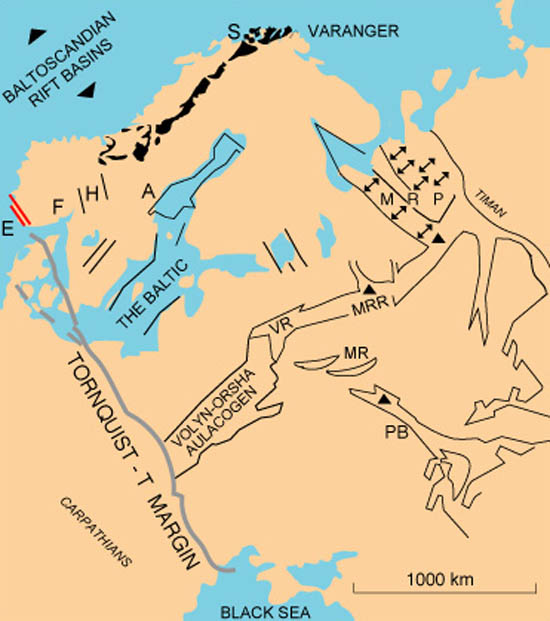
Figure 1: Schematic map showing distribution of known and inferred aulacogens in Baltica in late Neoproterozic time. The c. 1300 km long black belt along the Scandinavian Caledonides is the nappe complex which preserves dyke swarms, lavas and plutons associated with Baltoscandian rifting. A = Alnon carbonatite complex. E = Egersund dyke swarm. F = Fen carbonatite complex. H = Hedmark rift basin. MR = Moscow rift. MRR = Middle Russian rift. MRP = Mesen rift province. PB = Pachelma basin. S = Seiland Igneous Province. TM = Tornquist margin (also referred to as the Tornquist-Teisseyre Zone or Lineament). V = Valday rift. Black triangles in Neoproterozoic rifts indicate location of magmatism inferred from geophysics. Compiled from Kumpulainen and Nystuen (1985); Vidal and Moczydlowska (1995); Bogdanova et al. (1996); Kostyuchenko et al. (1999).
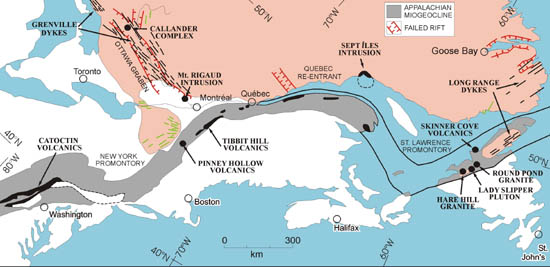
Figure 2: Late Neoproterozoic rift-related features and magmatism along the Iapetus margin of Laurentia. Magmatic units that are discussed in the text are labelled on the figure. Modified after McCausland and Hodych (1998) and Cawood et al. (2001).
Volynian Flood Basalt Province (VFBP)
The VFBP (Fig. 3) occupies an area of >200 000 km2 and attains a thickness of >600 m (Volovnik 1971). The VFBP derived its name from the Volyn-Orsha aulacogen (Fig. 1) which by tradition has been considered as the host structure of volcanism. However, Kruglov and Tsypko (1988) noted that the flood basalts fill a younger depression formed at the mouth of the Volyn-Orsha depression as a result of Rodinia break-up (cf. Znamenska and Chebanenko 1985; Poprawa and Paczesna 2002). Thus the Tornquist margin rather than the Riphean Volyn-Orsha aulacogen may be the main controlling structure. This also implies that the VFBP represents a part of once more widespread flood basalt province, fragmented by Rodinia breakup.
The volcanic sequence can be subdivided into three units: a lowermost of mainly basalts with subordinate tuff beds (85 to 350 m); a middle unit consisting of <220 m pyroclastic sediments and an upper unit comprising several basalt flows with rather abundant tuff and interlayers of pyroclastics and breccia (150-200 m). A basalt flow is typically 20-30 m thick and consists of a core of well-preserved basalt between upper and basal crusts. Crusts are aphyric and amygdaloidal. Core basalts contain 1-15% of palagonite glass, 45-70% plagioclase, 20-40% pyroxene and 5-10% opaque minerals. Less than 1 % phenocrysts (plagioclase>>pyroxene) and 1-2 % of small amygdules occur. The VFBP is famous for its native copper mineralization (Shumlyanskyy et al. 2002 and other papers in the same volume).
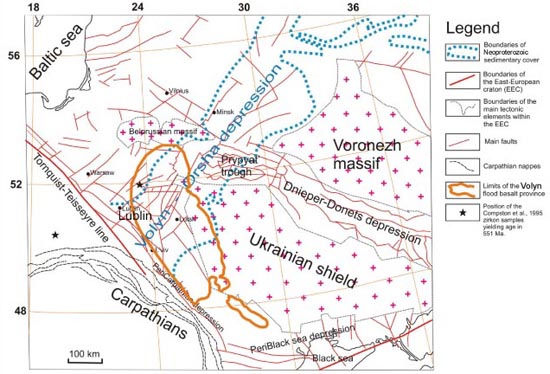
Figure 3: Location of the Volynian Flood Basalt Province. From Shumlyanskyy and Andréasson (2001).
Most of the basalt flows are tholeiitic in composition; a minor group of potassic composition (trachybasalt) also occurs. There is a subdivision into high-Ti and low-Ti basalts at similar Mg-numbers (only a few low-Ti basalt samples being more primitive: #Mg=0.54-0.63). The high-Ti samples derive from the uppermost levels of the volcanogenic sequence and definitively belong to a separate basalt flow. The high-Ti basalt is more enriched also with respect to high field strength elements including rare earth elements (Fig. 4). The VFBP exhibits other geochemical characteristics of continental flood basalts, and properties which may reflect a magma derived from an enriched mantle source, but contaminated by continental crust or subcontinental lithosphere (Condie 2001; Ernst and Buchan 2003). These include:
- similarity to oceanic island basalts with regard to trace elements, but with characteristic peaks for K, Ba, Th
- markedly enriched in LREE as compared to N-MORB
- enriched isotope signatures: eNd550 Ma = -2.7- -2.9 and 87Sr/86Sr550Ma = 0.707318-352 (low-Ti group).
- weak negative Ta-Nb anomalies in chondrite-normalized spidergrams
- crustal contamination: Nb/U (27); Ta/U (1.5); Ce/Pb (9-12).
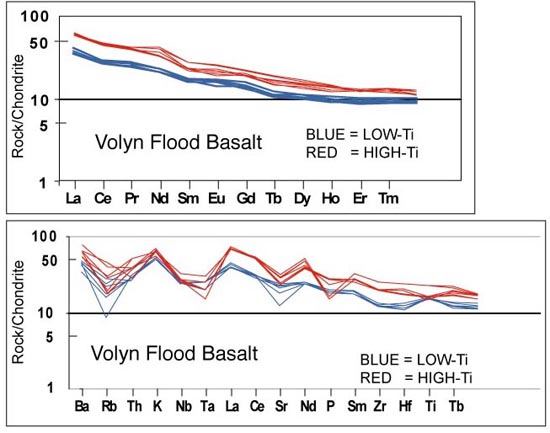
Figure 4: Chondrite-normalized multielement and REE variation diagrams of basalts from the Volynian province. From Shumlyanskyy and Andréasson (2004).
Numerous K-Ar analyses of basalts from the VFBP yielded ages between 560-540 Ma (Staritskyy 1981; Semenenko 1975). Elming et al. (2004) reported 40Ar-39Ar ages of 590-560 Ma for samples from four quarries of the Volyn province. Shumlyanskyy and Derevska (2002) obtained a Rb-Sr four-point isochron age of 552±59 Ma. Employing U-Pb ion microprobe technique (SHRIMP) on zircon, Compston et. al. (1995) obtained an age of 551±4 Ma from a tuff of the Slawatycze Formation on the Lublin Slope of Poland and correlated it with the uppermost Volynian volcanic sequence (cf. stars in Fig. 3). Shumlyanskyy and Andreasson (2004) carried out ion-microprobe analysis (NORDSIM) of eight zircons from samples taken from upper levels of the sequence. All crystals were euhedral and tabular to prismatic, colourless and displayed igneous oscillatory zoning, lacking cores and rims. Preliminary results were as follows: four crystals yielded near-concordant analyses with a weighted average 238U/232Th age of 554±16 Ma; MSWD = 1.49. Four other larger crystals yielded concordant analyses with a weighted average 238U/232Th age of 519±14 Ma; MSWD = 0.74. Th/U ratios were 1.0-1.7. A 206Pb/238U – 207Pb/235U discordia line constructed for all zircons except one corresponds to an age of 549±29 Ma; MSWD = 0.68.
Baltoscandian rift magmatism
Of large areal extent, the allochthons hosting Baltoscandian rift magmatism are still incompletely mapped and magmatism is poorly constrained with regard to geotectonic setting and also age. However, the various dyke swarms can be interpreted in terms of a rifted continental margin with an oceanward zonal variation with regard to age and mantle source (Andreasson 1994; Bingen and Demaiffe 1999). Today hosted by autochthonous basement, the Egersund dyke swarm must derive from inner parts of the rifted continental margin, possibly a failed arm. This 616±3 Ma old (U-Pb baddeleyite; Bingen et al. 2004) dyke swarm includes an alkaline (eNdi < +1; Sri = 0.7046) and a tholeiitic to mildly alkaline suite (+2.0èeNdiè3.1; Sri = 0.7037). A rare lava of continental tholeiitic affinity (Furnes et al. 1983) underlies the <610 Ma old (Bingen et al. 2004) Varangerian glaciogenic deposit of the Hedmark basin (H in Fig. 1) which has only been transported a short distance. The extensive dyke swarms of the rift basins cut an equivalent to the <610 Ma tillite. Dykes are tholeiitic, locally mildly alkaline, and enriched compared to MORB (Fig. 5; +4.8èeNdi è5.0; 0.7039-0.7028). Dykes of the continent-ocean transition have been dated at 608±1 Ma (U-Pb zircon; Svenningsen 2001). They compare to dykes of the rift basins but are less enriched in incompatible elements (eNdi è 6.6). Undated dyke-intruded gabbro and subordinate ultramafics of inferred ocean-floor derivation have OIB affinity and display a distinct positive Nb-Ta anomaly (red line in Fig. 5). The 577-554 Ma old magmatism of the Seiland Igneous Province (U-Pb zircon from three intrusions; Roberts et al. 2004) included emplacement of gabbroic and subordinate ultramafic and carbonatitic rocks cut by an alkaline dyke swarm. Alkaline syenite dykes intruded as late as 523 Ma (U-Pb zircon; Pedersen et al. 1989). The geochemistry of the intrusions is poorly investigated; however, Mg-rich and picritic compositions occur (Robins and Takla 1979; Bennet et al. 1986). Dyke swarms cutting some intrusions are enriched and approach OIB affinity (Fig. 5; Reginiussen et al. 1995). Alkaline and carbonatitic complexes of the platform include the 583±15 Ma old Fen complex (Meert et al. 1998) and the 584±13 Ma Alnon complex (Andersen 1996).
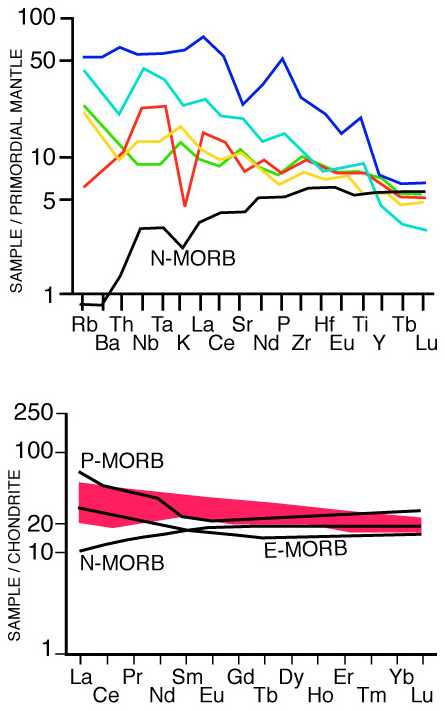
Figure 5:
Upper diagram: Primordial-normalized multielement and REE variation diagrams of Baltoscandian rift-related mafic dyke swarms and intrusions. Dark blue line: alkaline dykes of rift basins. Light blue line: alkaline dykes of Seiland Igneous Province. Red line: ocean floor. Green line: continent-ocean transition. Yellow line: tholeiitic dykes of rift basins. Data sources, see Andreasson et al. (1998). N-MORB pattern from Wilson (1989).
Lower diagram: The red field represents REE concentrations of the Baltoscandian dykes swarms compared to plume-type, enriched (E) and normal-type MORB. Data sources, see Andreasson et al. (1998). Alkaline dykes of the Seiland Igneous Province are not included. MORB patterns from Wilson (1989)..
Iapetus margin of Laurentia
Multiple stages of rifting are recorded along the Iapetus margin of Laurentia during the late Neoproterozoic to early Cambrian (e.g. Cawood et al., Waldron and van Staal 2001). Although magmatic activity in some areas dates from as early as ca. 760 Ma (Aleinikoff et al. 1995), we concentrate on the later episodes that began at ca. 615 Ma. Paleomagnetic evidence (McCausland and Hodych 1998) is consistent with the initiation of sea floor spreading at ca. 570 Ma. Another phase of rifting, perhaps involving a microcontinent or microcontinents, may be associated with later magmatism at ca. 550 Ma (Cawood et al. 2001, Waldron and van Staal 2001).
Post-615 Ma magmatism along the Iapetus margin of Laurentia (Fig. 2) is collectively referred to as the Central Iapetus magmatic event. It occurred semi-continuously from 615 to 535 Ma. Many of the magmatic units are now precisely dated and are described below. The oldest units are the extensive 615 ±2 Ma Long Range diabase dyke swarm (Kamo et al. 1989, Stukas and Reynolds 1974) and the coeval 617 ±8 Ma Hare Hill granite (van Berkel and Currie 1988). The Round Pond granite of western Newfoundland followed at 602 ±10 Ma (Williams et al. 1985). At 590 Ma the giant Grenville dyke swarm (Kamo et al. 1995) was emplaced along and parallel to the Ottawa graben, a failed rift that extends for 500 km into the craton (Kumarapeli et al. 1990). Alkalic intrusions, such as the 577±1 Ma Callander complex (Kamo et al. 1995), were emplaced in the Ottawa graben a short time later. Volcanic rocks of similar or slightly younger age are found along the margin, including the 572-564 Ma Catoctin volcanics (Aleinikoff et al. 1995) and 571 ±5 Ma Pinney Hollow volcanics (Walsh and Aleinikoff 1999). The 20,000 cu. km Sept Iles mafic layered intrusion was emplaced at 564 ±4 Ma (Higgins and van Breemen 1998). Volcanic rocks and plutons followed, including the 555 +3/-5 Ma Lady Slipper pluton (Cawood et al. 1996), the 554 +4/-2 Ma Tibbit Hill volcanics (Kumarapeli et al. 1989) and the 550 +3/-2 Ma Skinner Cove volcanics (McCausland and Hodych 1998). The youngest units are the 534 ±1 Ma Rigaud and 533 ±1 Ma Chatham-Grenville syenite intrusions of the Ottawa graben (McCausland et al. 2004).
Kumarapeli (1993) and Seymour and Kumarapeli (1995) examined the tectonic setting and chemistry of the prominent 590 Ma Grenville dyke swarm (Fig. 2). They concluded that the swarm was derived from a mantle plume head located in the vicinity of the Tibbit Hill volcanics, the site of a triple junction related to Iapetus rifting.
The overall geometry of the Grenville and Long Range dyke swarms (Fig. 2) has been interpreted to reflect subswarms of a giant radiating dyke swarm associated with a mantle plume (Ernst and Buchan 1997). Alternatively, the 25 my age difference between these two swarms and their geographic separation could indicate two distinct source regions along the Iapetus margin.
Puffer (2002) compared the chemistry of the volcanic rocks and dyke swarms of the Central Iapetus event of eastern Laurentia and concluded that it is consistent with mantle plume derivation. He divided the magmatic units into an older (615-564 Ma) “Mid-Vendian flood basalt group” and a younger (ca. 554-550 Ma) group which exhibits an ocean island basalt (OIB) affinity characterized by a greater enrichment in high field strength elements. The older group has a composition that resembles continental flood basalts which have been derived from a subcontinental lithospheric mantle source mixed with magma from a plume source. The younger group exhibits a regional variation in TiO2 and Zr, and the values peak just north of the Tibbit Hill triple junction suggesting a plume centre at this location.
Discussion
Volynian-Baltoscandian relations. The VFBP fulfils several critera of a LIP (Ernst and Buchan 2001; 2003); a notable exception is the presence of pyroclastics in the VFBP sequence, which is unlike most LIPs (but similar to the Siberian Traps). Available geochemical data provide little support for a link between Volynian magmatism and coeval Baltoscandian rift magmatism (i. e. the 550-580 Ma old Seiland Igneous Province). Only the lava of the Hedmark basin compares to the Volynian flood basalts; however, the Hedmark basalt is at least 50 Ma older than the VFBP. A hotspot-track relationship between the c. 550 Ma old VFBP and 584 Ma old alkaline-carbonatite complexes in Scandinavia is inconsistent with a presumably ”eastward” movement of Baltica after breakup. Too little is at present known about the magmatism hosted by Neoproterozic rift basins elsewhere in the East European Craton (triangles in Fig. 1) for a discussion of potential links to the VFBP.
Volynian-Baltoscandian-Laurentian relations. The Volynian and Baltoscandian margins of Baltica and the Iapetus margin of Laurentia have in common a rift magmatic evolution characterized by early (ca. 620-590 Ma) mainly tholeiitic dyking (Egersund, Särv, Seve-Kalak, Long Range and Grenville), 570-550 mainly tholeitic volcanism (Catoctin and Volyn) and an overlapping (ca. 580-520 Ma) phase of more alkaline character including plutonism (e.g. Seiland plutonism, Fen and Alnon carbonatite complexes; Skinner Cove, Lady Slipper, Tibbit Hill). It is tempting to interpret this evolution in terms of triple-junction rifting and generated by a single, major plume (Bingen et al. 1998; Ernst and Buchan 2001).
However, the paleogeographic relationship between Baltica and Laurentia at the time of emplacement of the Volyn flood basalts and coeval magmatism elsewhere in Baltica and Laurentia is highly controversial because of uncertainties in the interpretation of paleomagnetic data currently available. Firstly, the paleolatitude of Laurentia is uncertain. For example, McCausland and Hodych (1998) and Hodych et al. (2004) suggest that the present-day eastern margin of Laurentia was at a latitude of about 10-20° at 550 Ma. On the other hand, Hartz and Torsvik (2002, Fig. 2) locate this portion of Laurentia at about 70-80°. In addition the location and azimuthal orientation of Baltica based on paleomagnetic data are equally controversial. Some authors place the present-day western margin of Baltica adjacent to eastern Greenland (e.g. Torsvik et al. 1996; Meert and Van der Voo 1997) prior to breakup of Baltica and Laurentia. Recently, however, Hartz and Torzvik (2002) and Torsvik (2003) have suggested that paleomagnetic results are consistent with the eastern margin of Baltica adjacent to Greenland at this time. More reliable paleomagnetic poles from the two continental blocks are required to establish the relative locations of these blocks in the late Neoproterozoic, and therefore, the relative locations of the Volyn-Baltoscandian magmatism and that of eastern Laurentia.
References
Aleinikoff, J.N., Zartman, R.E., Walter, M., Rankin, D.W., Lyttle, P.T. and Burton, W.C., 1995. U-Pb ages of metarhyolites of the Catoctin and Mount Rogers Formations, central and southern Appalachians: evidence for two pulses of Iapetan rifting. American Journal of Science, 255, 428-454.
Andersen, T., 1996. Sr, Nd, and Pb characteristics of the Alnö carbonatite complex, Sweden. 22nd Nordic Geological Winter Meeting, Turku, Finland, p. 11 (Abstract).
Andreasson, P.G., 1994. The Baltoscandian Margin in Neoproterozoic - Early Palaeozoic time. Some constraints on terrane derivation and accretion in the Arctic Scandinavian Caledonides. Tectonophysics, 231, 1-32.
Andreasson, P.G. and Albrecht, L.G., 1995. Derivation of 500 Ma eclogites from the passive margin of Baltica and a note on the metamorphic and structural heterogeneity of eclogite-bearing crust. Geological Magazine, 132, 729-738.
Andreasson, P.G., Svenningsen, O.M. and Albrecht, L., 1998. Dawn of Phanerozoic orogeny in the North Atlantic tract; Evidence from the Seve-Kalak Superterrane, Scandinavian Caledonides. GFF, 120, 159-172.
Bakun-Czubarow N., Bialowolska A. and Fedoryshyn Y., 2002. Neoproterozoic flood basalts of of Zabolottya and Babino beds of their volcanogenic Volynian Series and Polesie Series dolerites in the western margin of the East European Craton. Acta Geologica Polonica 52, 481-496.
Bennett, M.C., Emblin, S.R., Robins, B. et al., 1986. High-temperature ultramafic complexes in the North Norwegian Caledonides: I - Regional setting and field relationships. Norges Geologiske Undersokelse Bulletin, 405, 1-40.
Bialowolska, A., Bakun-Czubarow, N. and Fedoryshyn, Y., 2002. Neoproterozoic flood basalts of the upper beds of the Volhynian Series (East European Craton). Geological Quarterly 46, 37-57.
Bingen, B. and Demaiffe, D., 1999. Geochemical signature of the Egersund basaltic dyke swarm, SW Norway, in the context of late-Proterozoic opening of the Iapetus Ocean. Norsk Geologisk Tidsskrift 79, 69-86.
Bingen, B., Demaiffe, D. and van Breemen, O., 1998. The 616 Ma old Egersund dike swarm, SW Norway, and Late Neoproterozoic opening of the Iapetus Ocean. Journal of Geology 106, 565-574.
Bingen, B., Griffin, W.L. and Saeed, A., 2004. Detrital zircon signature of Baltica during the Neoproterozoic: LA-ICP-MS U-Pb and Lu-Hf study of the Lower Allochthon of SE Norway and implications (Abstract). GFF, 126, 78.
Bogdanova, S.V., Pashkevich, I.K., Gorbatschev, R. and Orlyuk, M.I., 1996. Riphean rifting and major Palaeoproterozoic crustal boundaries in the basement of the East European Craton: geology and geophysics. Tectonophysics 268, 1-21.
Cawood, P.A., McCausland, P.J.A. and Dunning, G.R., 2001. Opening Iapetus: constraints from the Laurentian margin in Newfoundland. Geological Society of America Bulletin 113, 443-453.
Cawood, P.A., van Gool, J.A.M. and Dunning, G.R., 1996. Geological development of eastern Humber and western Dunnage zones: Corner Brook-Glover Island region, Newfoundland. Canadian Journal of Earth Sciences 33, 182-198.
Compston, W., Sambridge, M.S., Reinfrank, R.F. et al., 1995. Numerical ages of volcanics and the earliest faunal zone within the Late Precambrian of East Poland. Journal of the Geological Society of London 152, 599-611.
Condie, K. C., 2001. Mantle Plumes and Their Record in Earth History. Cambridge University Press, Cambridge, 306 pp.
Dallmeyer, R.D., Andréasson, P.G. and Svenningsen, O.M., 1991. Early tectonothermal evolution of the Scandinavian Caledonides: constraints from Ar40/Ar39 mineral ages within the Seve terranes of the Sarek Mts., north Sweden. Journal of Metamorphic Geology, 9, 203-218.
Dalziel I.W., 1997. Neoproterozoic-Paleozoic geography and tectonics: reviews, hypothesis, environmental speculations. Geological Society of America Bulletin 109, 16-42.
Elming, S.A., Kravchenko, S., Khramov, A.N. et al., 2004. Paleomagnetism and 40Ar/39Ar age determinations of the Ediacaran traps from the southwestern margin of the East European Craton, Ukraine: relevance to the Rodinia break-up. Supercontinents, remagnetizations and geomagnetic modelling. 5th Nordic Paleomagnetic Workshop in Helsinki, Finland, September 25-30, 2004, p. 5-6.(Extended Abstract).
Ernst, R.E., and Buchan, K.L., 1997. Giant radiating dyke swarms: their use in identifying pre-Mesozoic Large Igneous Province and mantle plumes. In Mahoney, J.J. and Coffin (eds.), Large Igneous Provinces: continental, oceanic and planetary flood volcanism, American Geophysical Union Geophysical Monograph 100, p. 297-333.
Ernst, R.E and Buchan, K.L., 2001. The use of mafic dike swarms in identifying and locationg mantle plumes. In: Ernst, R.E and Buchan, K.L. (Eds.) Mantle Plumes: Their Identification Through Time. Geological Society of America Special Paper 352, p. 247-265.
Ernst, R.E and Buchan, K.L., 2003. Recognizing Mantle Plumes in the Geological Record. Annual Review of Earth and Planetary Sciences 31, 469-523.
Furnes, H., Nystuen, J.P., Brunfelt, A.O. et al., 1983. Geochemistry of Upper Riphean - Vendian basalts associated with the ‘sparagmites’ of southern Norway. Geological Magazine 120, 349-361.
Garris M.A., Keller B.M., Postnikov D.V. et. al., 1973. Geochronology of the USSR. V. 1. Nedra, 111-125. (In Russian).
Goyzhevskyy A.A., Skarzhinskyy V.I., Shumlyanskyy V.A. et. al., 1984. Phanerozoic metallogeny of the platformal region of Ukraine. Naukova dumka publisher, 204 pp. (In Russian).
Hartz, E.H. and Torsvik, T.H., 2002. Baltica upside down: a new plate tectonic model for Rodinia and the Iapetus ocean. Geology 30, 255-258.
Higgins, M.D., and van Breemen, O., 1998. The age of the Sept Iles layered mafic intrusion, Canada: implications for the late Neoproterozoic/Cambrian history of southeastern Canada. Journal of Geology 106, 421-431.
Hodych, J.P., Cox, R.A. and Kosler, J., 2004. An equatorial Laurentia at 550 Ma confirmed by Grenvillian inherited zircons dated by LAM ICP-MS in the Skinner Cove volcanics of western Newfoundland: implications for inertial interchange true polar wander. Precambrian Research 129, 93-113.
Kamo, S.L., Gower, C.F. and Krogh, T.E., 1989. Birthdate for the Iapetus Ocean? A precise U-Pb zircon and baddeleyite age for the Long Range dikes, southeast Labrador. Geology 17, 602-605.
Kamo, S.L., Krogh, T.E. and Kumarapeli, P.S., 1995. Age of the Grenville dyke swarm, Ontartio-Quebec: implications for the timing of Iapetan rifting. Canadian Journal of Earth Sciences 32, 273-280.
Karpinskiy, A.P., 1874. Report about basaltic rock in the Rovno district of the Volynian region. Proceedings of the society of naturalists V, No 2. (In Russian).
Kostyuchenko, S.L., Egorkin, A.V. and Solodilov, L.N., 1999. Structure and genetic mechanisms of the Precambrian rifts of the East-European Platform in Russia by integrated study of seismic, gravity, and magnetic data. EUROPROBE GeoRift Special Issue volume 2. Tectonophysics 313, 9-28.
Kumarapeli, P.S., 1993. A plume-generated segment of the rifted margin of Laurentia, southern Canadian Appalachians, seen through a completed Wilson cycle. Tectonophysics 219, 47-55.
Kumarapeli, P.S., Dunning, G.R., Pintson, H. and Shaver, J., 1989. Geochemistry and U-Pb zircon age of comenditic metafelsites of the Tibbit Hill Formation, Quebec Appalachians. Canadian Journal of Earth Sciences 26, 1374-1383.
Kumarapeli, P.S., Seymour, K. St., Fowler, A. and Pintson, H., 1990. The problem of the magma source of a giant radiating mafic dyke swarmin a failed arm setting.. In: Parker, A.J., Rickwood, P.C. and Tucker, D.H. (eds), Mafic dykes and emplacement mechanisms, Balkema, Rotterdam, p. 163-183.
Kumpulainen, R. and Nystuen, J-P., 1985. Late Proterozoic basin evolution and sedimentation in the westernmost part of Baltoscandia. In: The Caledonide Orogen – Scandinavia and Related Areas (D.G. Gee and B.A. Sturt ed.), pp. 213-232. John Wiley & Sons, Chichester.
Kruglov S.S. and Tsypko, A.K. (Eds.), 1988. Tectonics of Ukraine. Nedra, Moscow, 1988. 254 pp.
Leaver, J.M., Bennett, M.C. and Robins, B., 1989. Xenolithic dykes on Seiland and the preliminary observations on the lithospheric mantle beneath the Seiland Province, W Finnmark, Norway. In: The Caledonide Geology of Scandinavia (R.A. Gayer ed.), pp. 165-174. Graham & Trotman, London.
McCausland, P.J.A. and Hodych, J.P., 1998. Paleomagnetism of the 550 Ma Skinner Cove volcanics of western Newfoundland and the opening of the Iapetus Ocean. Earth and Planetary Science Letters 163, 15-29.
McCausland, P.J., Van der Voo, R. and Hall, C.M., 2004. Paleomagnetic confirmation of a low-latitude Laurentia by 534 Ma. American Geophysical Union/Canadian Geophysical Union abstract.
Meert, J.C. and Van der Voo, R., 1997. The assembly of Gondwana 800-550 Ma. Journal of Geodynamics 23, 223-235.
Meert, J.G., Torsvik, T.H., Eide, E.A. and Dahlgren, S., 1998. Tectonic significance of the Fen Province, S. Norway: Constraints from Geochronology and Paleomagnetism. J. Geology 106, 553-564.
Moczydlowska, M., 1988. Thermal alteration of the organic matter around the Precambrian-Cambrian transition in the Lublin Slope of the East European Platform of Poland. Geologiska Föreningens i Stockholm Förhandlingar 110, 351-361.
Nikishin, A. M., Ziegler, P. A., Stephenson, R. A. et al., 1996. Late Precambrian to Triassic history of the East European Craton: dynamics and sedimentary basin evolution. Tectonophysics 268, 23-63.
Nitke, V.N., Markovskyy V.M., Makovskaya N.A., 1976. Neoproterozoic deposits of the western region of Ukraine as evidenced by deep-drillig data. Tectonika I stratigrafiya 11, 61-74. (In Russian).
Pedersen, R.B., Dunning, G.R. and Robins, B., 1989. U-Pb ages of nepheline-syenite pegmatites from the Seiland Magmatic Province, N. Norway. In: The Caledonide Geology of Scandinavia (R.A. Gayer ed.), pp. 3-8. Graham & Trotman, London.
Postnikova, N.E., 1977. Late Precambrian of the East-European platform and its oil-bearing capasity. Nedra, 222 p. (In Russian).
Poprawa, P. and Paczesna, J., 2002. Development of rift in Late Neoproterozoic – Early Paleozoic at the Lublin-Polesie slope of the East-European craton – analysis of subsidence and facial record. Prz. Geol. 50, 49-63. (In Polish).
Puffer, J.H., 2002. A late Neoproterozoic Eastern Laurentian superplume: location, size, chemical composition, and environmental impact. American Journal of Science 302, 1-27.
Reginiusen, H., Krogh Ravna, E.J. and Berglund, K., 1995. Mafic dykes from Oksfjord, Seiland Igneous Province, northern Norway: geochemistry and palaeotectonic significance. Geological Magazine 132, 667-681.
Roberts, R.J., Corfu, F., Torsvik, T.H., Ramsay, D.M. and Ashwal, L.D., 2004. Redefining the magmatic evolution of the Kalak Nappe Complex (Abstract). GFF, 84.
Robins, B. and Takla, M.A., 1979. Geology and geochemistry of a metamorphosed picrite-ankaramite dyke-suite from the Seiland province, northern Norway. Norsk Geologisk Tidsskrift 59, 67-95.
Semenenko, N.P. (Ed.), 1975. Mineral deposits forecasting Criteria for the Ukrainian shield and its folded framing. Naukova dumka publisher, 560 pp. (In Russian).
Seymour, K. St. and Kumarapeli, P.S., 1995. Geochemistry of the Grenville dyke swarm: role of plume-source mantle in magma genesis. Contributions to Mineralogy and Petrology 120, 29-41.
Shumlyanskyy, L.V. and Andreasson, P.G., 2004. New geochemical and geochronological data from the Volyn Flood Basalt in Ukraine and correlation with large igneous events in Baltoscandia (Abstract). GFF, 126, 85-86.
Shumlyanskyy L.V. and Derevska K.I., 2004. Chemical composition of the main rock-forming minerals of basalts and dolerites of the Vendian flood basalts of the Volynian region. Mineralogical collections of the L’viv University 54, 48-63. (In Ukrainian).
Shumlyanskyy, V., Pryhodko, V., Zhykalyak, M. and Zagnitko, V., 2002. The main geological economic types of copper depoaits in Ukraine. In: Copper of the Volynian Region. Proceedings of the Institute of Fundamental Studies. Kyiv, Znannya, p. 93-111. (In Ukrainan with abstract in English. This is one of several short papers in the same volume dealing with the Volynian native copper mineralizations).
Soper, N.J., 1994. Neoproterozoic sedimentation on the northeast margin of Laurentia and the opening of Iapetus. Geological Magazine 131, 291-299.
Staritskyy, Yu.G. (Ed.), 1981. History of development and mineralogy of cover of the East-European platform. Nedra, 224 pp. (In Russian).
Stukas, V. and Reynolds, P.H., 1974. 40Ar/39Ar dating of the Long Range dikes, Newfoundland. Earth and Planetary Science Letters 22, 256-266
Svenningsen, O.M., 2001. Onset of seafloor spreading in the Iapetus Ocean: precise age of the Sarek Dyke Swarm, northern Swedish Caledonides. Precambrian Research 110, 241-245.
Torsvik, T.H., 2003. The Rodinia jigsaw puzzle. Science 300, 1379-1381.
Torsvik, T.H., Smethurst, M.A., Van der Voo, R. et al., 1992. Baltica. A synopsis of Vendian-Permian palaeomagnetic data and their palaeotectonic implications. Earth-Science Reviews 33, 133-152.
Torsvik, T.H., Smethurst, M.A., Meert, J.G. et al., 1996. Continental break-up and collision in the Neoproterozoic and Palaeozoic - A tale of Baltica and Laurentia. Earth-Science Reviews 40, 229-258.
Torsvik, T.H. and Rehnström, E.F., 2001. Cambrian palaeomagnetic data from Baltica: implications for true polar wander and Cambrian palaeogeography. J. Geological Society London 158, 321-329.
Ushakova Z.G., 1976. Riphean and Vendian igneous rocks in sedimentary cover of the East-European platform. In: Geology, petrology and metallogeny of the crystalline formations of the East-European platform, V. 2, 16-20. Nedra (In Russian).
Van Berkel, J.T. and Currie, K.L., 1988. Geology of the Puddle Pond (12A/5) and Little Grand Lake (12A/12) map areas, southwestern Newfoundland. Newfoundland Department of Mines, Mineral Development Division Report, v. 88-1, p. 99-107.
Velikanov V.A., Aseeva E.A., Fedonkin M.A., 1983. Vendian deposits of Ukraine. Naukova dumka publisher, Kyiv. 164 pp. (In Russian).
Vidal, G. and Moczydlowska, M., 1995. The Neoproterozoic of Baltica - stratigraphy, palaeobiology and general geological evolution. Precambrian Research 73, 197-216.
Volovnik, B.Y., 1971. Petrology and mineralogy of the Volyno-Podolian flood basalts. Ph.D. thesis, L'viv, 1971 (In Russian).
Waldron, J.W.F. and van Staal, C.R., 2001. Taconian orogeny and the accretion of the Dashwood block: A peri-Laurentian microcontinent in the Iapetus Ocean. Geology 29, 811-814.
Walsh, G.J. and Aleinikoff, J.N., 1999. U-Pb zircon age of metafelsite from the Pinney Hollow Formation: implications for the development of the Vermont Appalachians. American Journal of Science 299, 157-170.
Williams, H. and Gillespie, R.T. and van Breemen, O., 1985. A late Precambrian rift-related igneous suite in western Newfoundland. Canadian Journal of Earth Sciences 22, 1727-1735.
Wilson, M., 1989. Igneous Petrogenesis. A Global Tectonic Approach. Unwin Hyman. 466 pp.
Znamenskaya, T.A., Chebanenko, I.I., 1985. Block tectonics of the Volyno-Podolian region. Naukova Dumka, Kyiv, 156 p.
Znamenskaya, T.A. Korenchuk L.V. and Pryhodko V.L., 1990. Palaeotectonic conditions of deposition of Volynian Series of the Volyno-Podolian region. Geological Journal 3, 133-141. (In Russian).
